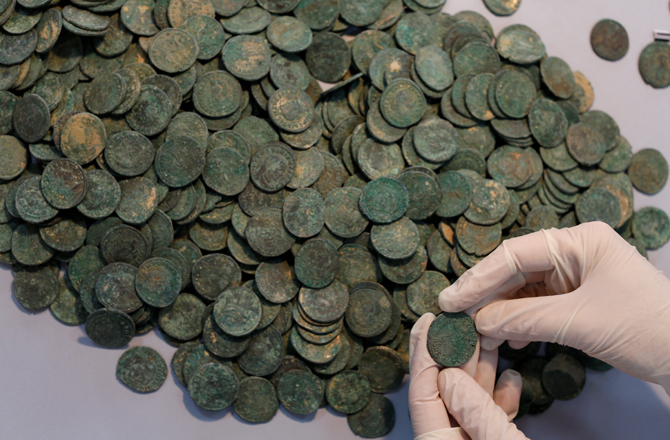Friday, April 27th, 2016. It was just a routine day for a group of Spanish construction workers in southern Spain, in the town of Tomares, near Seville, an Andalusian capital. The group had been working on a water pipeline when they stumbled across a huge cache of Roman coins. They found the cache stored inside 19 different Roman amphorae (a type of pottery jar with two handles and a spout, usually used to transport wine).
The coins were stamped with the faces of Maximilian and Constantine, two very well known Emperors in Roman history. The coins date back to the late third and fourth centuries, the same time Constantine turned Byzantium into Constantinople, the Huns were invading the Sassanid Empire. St. Ambrose was Bishop of Milan, and Augustine of Hippo was writing his Confessions.
Rome conquered the Iberian Peninsula, the area around Spain, around 218 BC. They called it “Hispania”, and used it as a training ground for officers and soldiers. The Roman Emperor Augustus Caesar was the first to complete the entire conquest of the Iberian Peninsula. The population was admitted into the Roman upper class, and the Romans improved existing cities, as well as adding their own. By the 1st Century AD, The Romanized Iberian population and the natural-born offspring of Roman colonists had achieved citizenship. Emperors Trajan and Marcus Aurelius were, interestingly enough, from the region. Marcus Aurelius is, of course, famous for his book Meditations, a book that has influenced our understanding of Stoic philosophy. “Hispania” was known to produce tough soldiers and commanders.
Rome continued to dominate the area until the collapse of the Western Roman Empire in the 5th century. Once Rome could no longer support the soldiers that held Hispania in direct thrall to the Empire, the Romans were quickly pushed out by the Visigoths and other surrounding tribes that lived in the Iberian Peninsula.
The coins found were freshly minted, according to the archaeologists who looked them over. Most of them were made from bronze. Some were partially covered in silver. They were probably never in circulation, as they were fairly clean and haven’t been worn down from use. What was the point of stashing away 1300 pounds of bronze coins, all the way in the Roman boonies of the Iberian Peninsula? Well, archaeologists are speculating that the 19 amphorae filled with money were meant to be payment to soldiers or civil officials in the area. That’s their best guess.
Local officials have decided to halt work on the piping in the area where the coins were found so that archaeologists can move in and excavate. It’s important to make sure that no history is destroyed in the process of construction. Ana Navarro is the head of Seville’s Museum of Archaeology, who’s overseeing the project and looking after the find. She says it’s a “unique collection”, and has declined to put an exact monetary value on the coins. They may come to several million euros worth of money, but their contribution to the narrative of history in Spain is priceless.


